Principles of Person Centered Care
VerifiedAdded on 2022/12/15
|9
|2301
|89
AI Summary
This article discusses the principles of person-centered care and the role of nurses in providing this type of care. It covers topics such as respecting patients' preferences, coordinating and integrating care, providing physical comfort, offering education and information, involving friends and family, providing emotional support, ensuring continuity and transition, and promoting access to care. The article also explores how nurses can partner with consumers to improve the safety and quality of their care.
Contribute Materials
Your contribution can guide someone’s learning journey. Share your
documents today.
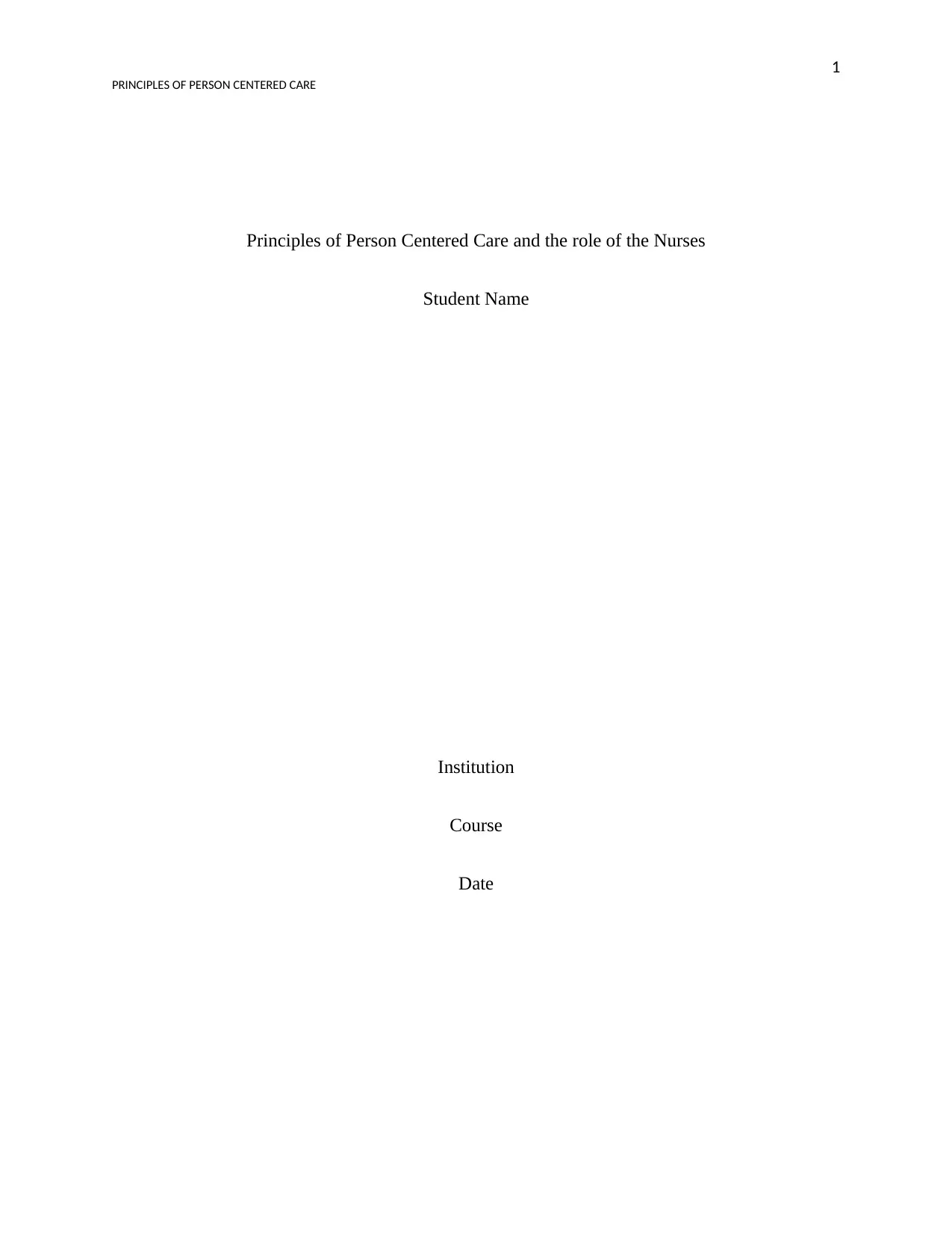
1
PRINCIPLES OF PERSON CENTERED CARE
Principles of Person Centered Care and the role of the Nurses
Student Name
Institution
Course
Date
PRINCIPLES OF PERSON CENTERED CARE
Principles of Person Centered Care and the role of the Nurses
Student Name
Institution
Course
Date
Secure Best Marks with AI Grader
Need help grading? Try our AI Grader for instant feedback on your assignments.
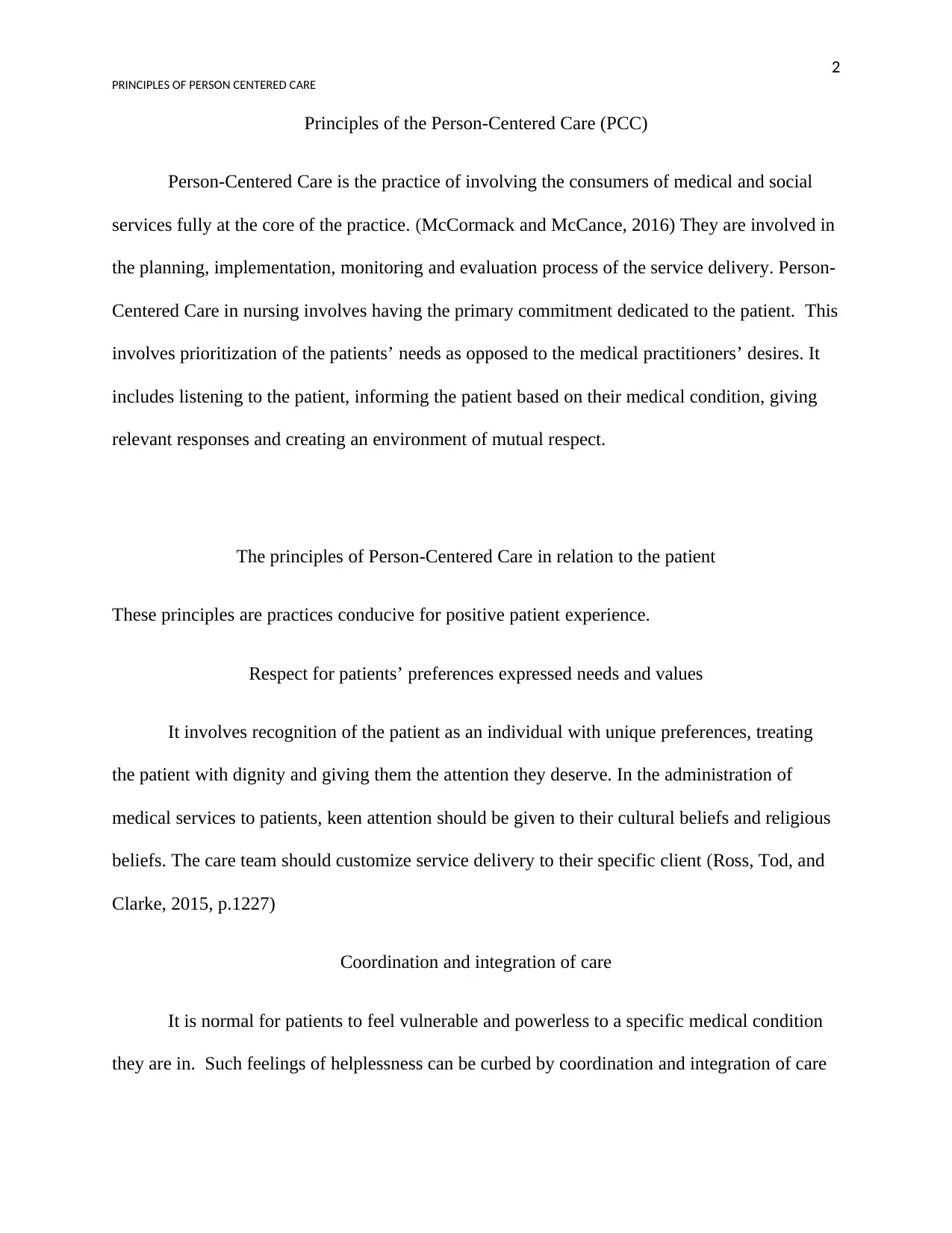
2
PRINCIPLES OF PERSON CENTERED CARE
Principles of the Person-Centered Care (PCC)
Person-Centered Care is the practice of involving the consumers of medical and social
services fully at the core of the practice. (McCormack and McCance, 2016) They are involved in
the planning, implementation, monitoring and evaluation process of the service delivery. Person-
Centered Care in nursing involves having the primary commitment dedicated to the patient. This
involves prioritization of the patients’ needs as opposed to the medical practitioners’ desires. It
includes listening to the patient, informing the patient based on their medical condition, giving
relevant responses and creating an environment of mutual respect.
The principles of Person-Centered Care in relation to the patient
These principles are practices conducive for positive patient experience.
Respect for patients’ preferences expressed needs and values
It involves recognition of the patient as an individual with unique preferences, treating
the patient with dignity and giving them the attention they deserve. In the administration of
medical services to patients, keen attention should be given to their cultural beliefs and religious
beliefs. The care team should customize service delivery to their specific client (Ross, Tod, and
Clarke, 2015, p.1227)
Coordination and integration of care
It is normal for patients to feel vulnerable and powerless to a specific medical condition
they are in. Such feelings of helplessness can be curbed by coordination and integration of care
PRINCIPLES OF PERSON CENTERED CARE
Principles of the Person-Centered Care (PCC)
Person-Centered Care is the practice of involving the consumers of medical and social
services fully at the core of the practice. (McCormack and McCance, 2016) They are involved in
the planning, implementation, monitoring and evaluation process of the service delivery. Person-
Centered Care in nursing involves having the primary commitment dedicated to the patient. This
involves prioritization of the patients’ needs as opposed to the medical practitioners’ desires. It
includes listening to the patient, informing the patient based on their medical condition, giving
relevant responses and creating an environment of mutual respect.
The principles of Person-Centered Care in relation to the patient
These principles are practices conducive for positive patient experience.
Respect for patients’ preferences expressed needs and values
It involves recognition of the patient as an individual with unique preferences, treating
the patient with dignity and giving them the attention they deserve. In the administration of
medical services to patients, keen attention should be given to their cultural beliefs and religious
beliefs. The care team should customize service delivery to their specific client (Ross, Tod, and
Clarke, 2015, p.1227)
Coordination and integration of care
It is normal for patients to feel vulnerable and powerless to a specific medical condition
they are in. Such feelings of helplessness can be curbed by coordination and integration of care
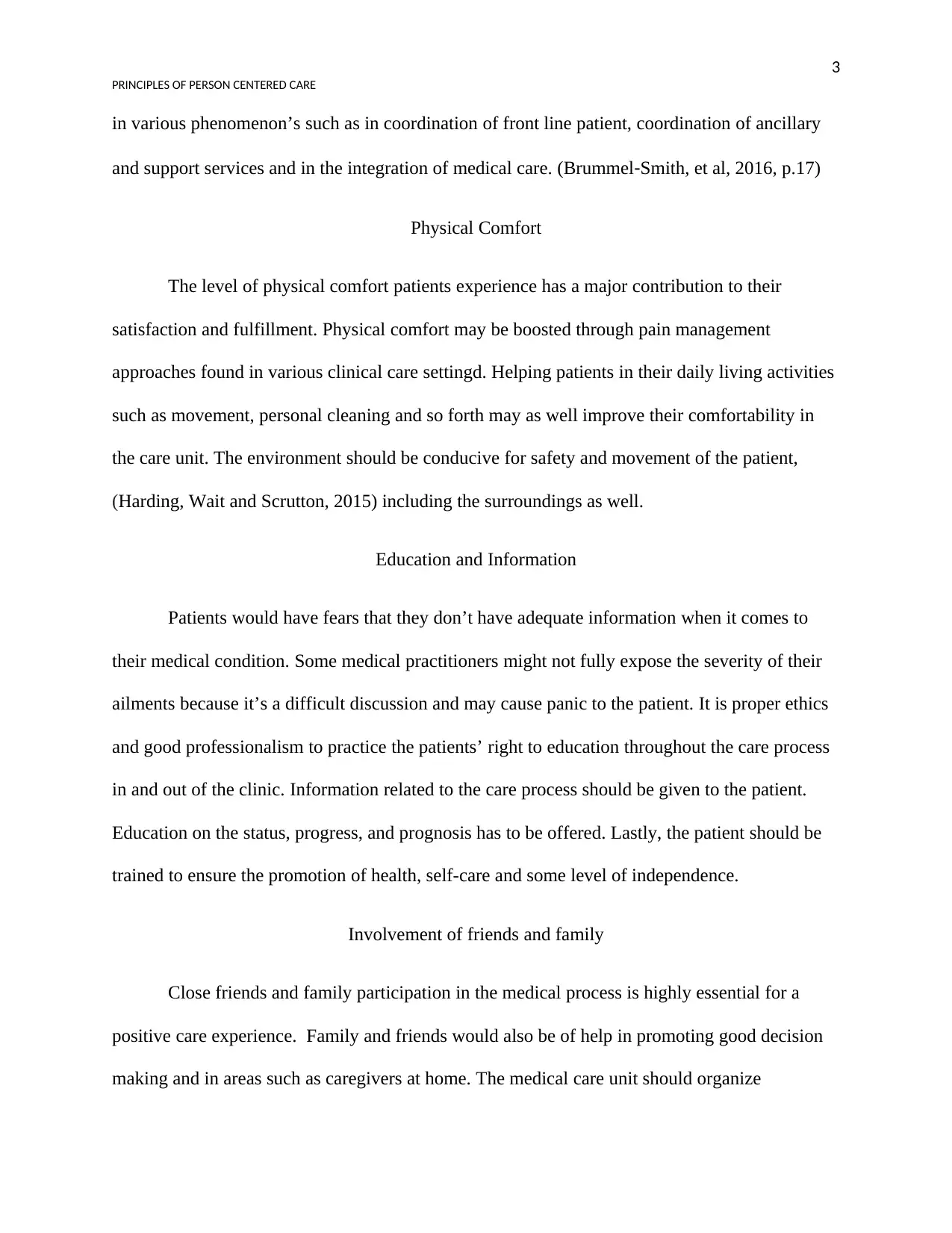
3
PRINCIPLES OF PERSON CENTERED CARE
in various phenomenon’s such as in coordination of front line patient, coordination of ancillary
and support services and in the integration of medical care. (Brummel‐Smith, et al, 2016, p.17)
Physical Comfort
The level of physical comfort patients experience has a major contribution to their
satisfaction and fulfillment. Physical comfort may be boosted through pain management
approaches found in various clinical care settingd. Helping patients in their daily living activities
such as movement, personal cleaning and so forth may as well improve their comfortability in
the care unit. The environment should be conducive for safety and movement of the patient,
(Harding, Wait and Scrutton, 2015) including the surroundings as well.
Education and Information
Patients would have fears that they don’t have adequate information when it comes to
their medical condition. Some medical practitioners might not fully expose the severity of their
ailments because it’s a difficult discussion and may cause panic to the patient. It is proper ethics
and good professionalism to practice the patients’ right to education throughout the care process
in and out of the clinic. Information related to the care process should be given to the patient.
Education on the status, progress, and prognosis has to be offered. Lastly, the patient should be
trained to ensure the promotion of health, self-care and some level of independence.
Involvement of friends and family
Close friends and family participation in the medical process is highly essential for a
positive care experience. Family and friends would also be of help in promoting good decision
making and in areas such as caregivers at home. The medical care unit should organize
PRINCIPLES OF PERSON CENTERED CARE
in various phenomenon’s such as in coordination of front line patient, coordination of ancillary
and support services and in the integration of medical care. (Brummel‐Smith, et al, 2016, p.17)
Physical Comfort
The level of physical comfort patients experience has a major contribution to their
satisfaction and fulfillment. Physical comfort may be boosted through pain management
approaches found in various clinical care settingd. Helping patients in their daily living activities
such as movement, personal cleaning and so forth may as well improve their comfortability in
the care unit. The environment should be conducive for safety and movement of the patient,
(Harding, Wait and Scrutton, 2015) including the surroundings as well.
Education and Information
Patients would have fears that they don’t have adequate information when it comes to
their medical condition. Some medical practitioners might not fully expose the severity of their
ailments because it’s a difficult discussion and may cause panic to the patient. It is proper ethics
and good professionalism to practice the patients’ right to education throughout the care process
in and out of the clinic. Information related to the care process should be given to the patient.
Education on the status, progress, and prognosis has to be offered. Lastly, the patient should be
trained to ensure the promotion of health, self-care and some level of independence.
Involvement of friends and family
Close friends and family participation in the medical process is highly essential for a
positive care experience. Family and friends would also be of help in promoting good decision
making and in areas such as caregivers at home. The medical care unit should organize
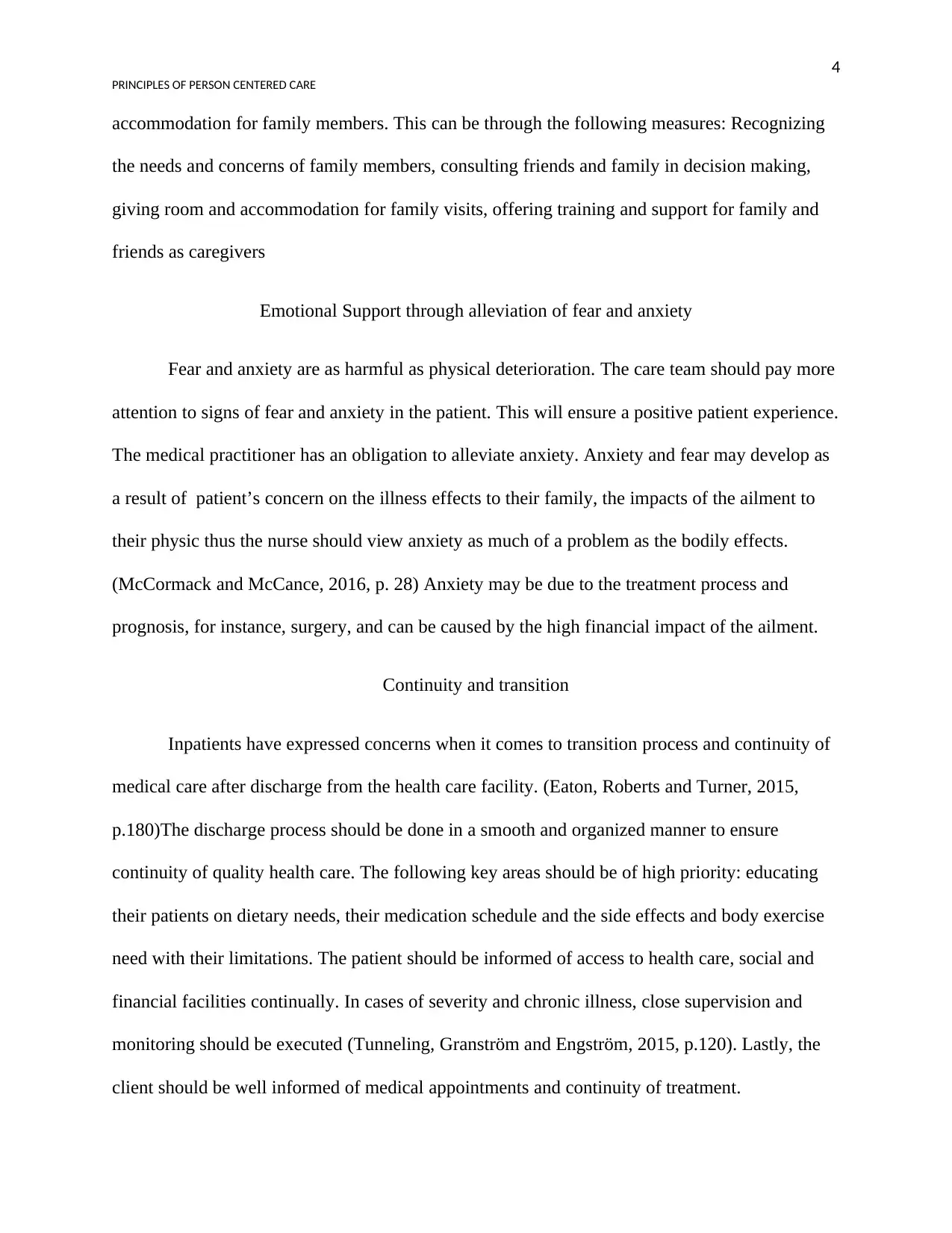
4
PRINCIPLES OF PERSON CENTERED CARE
accommodation for family members. This can be through the following measures: Recognizing
the needs and concerns of family members, consulting friends and family in decision making,
giving room and accommodation for family visits, offering training and support for family and
friends as caregivers
Emotional Support through alleviation of fear and anxiety
Fear and anxiety are as harmful as physical deterioration. The care team should pay more
attention to signs of fear and anxiety in the patient. This will ensure a positive patient experience.
The medical practitioner has an obligation to alleviate anxiety. Anxiety and fear may develop as
a result of patient’s concern on the illness effects to their family, the impacts of the ailment to
their physic thus the nurse should view anxiety as much of a problem as the bodily effects.
(McCormack and McCance, 2016, p. 28) Anxiety may be due to the treatment process and
prognosis, for instance, surgery, and can be caused by the high financial impact of the ailment.
Continuity and transition
Inpatients have expressed concerns when it comes to transition process and continuity of
medical care after discharge from the health care facility. (Eaton, Roberts and Turner, 2015,
p.180)The discharge process should be done in a smooth and organized manner to ensure
continuity of quality health care. The following key areas should be of high priority: educating
their patients on dietary needs, their medication schedule and the side effects and body exercise
need with their limitations. The patient should be informed of access to health care, social and
financial facilities continually. In cases of severity and chronic illness, close supervision and
monitoring should be executed (Tunneling, Granström and Engström, 2015, p.120). Lastly, the
client should be well informed of medical appointments and continuity of treatment.
PRINCIPLES OF PERSON CENTERED CARE
accommodation for family members. This can be through the following measures: Recognizing
the needs and concerns of family members, consulting friends and family in decision making,
giving room and accommodation for family visits, offering training and support for family and
friends as caregivers
Emotional Support through alleviation of fear and anxiety
Fear and anxiety are as harmful as physical deterioration. The care team should pay more
attention to signs of fear and anxiety in the patient. This will ensure a positive patient experience.
The medical practitioner has an obligation to alleviate anxiety. Anxiety and fear may develop as
a result of patient’s concern on the illness effects to their family, the impacts of the ailment to
their physic thus the nurse should view anxiety as much of a problem as the bodily effects.
(McCormack and McCance, 2016, p. 28) Anxiety may be due to the treatment process and
prognosis, for instance, surgery, and can be caused by the high financial impact of the ailment.
Continuity and transition
Inpatients have expressed concerns when it comes to transition process and continuity of
medical care after discharge from the health care facility. (Eaton, Roberts and Turner, 2015,
p.180)The discharge process should be done in a smooth and organized manner to ensure
continuity of quality health care. The following key areas should be of high priority: educating
their patients on dietary needs, their medication schedule and the side effects and body exercise
need with their limitations. The patient should be informed of access to health care, social and
financial facilities continually. In cases of severity and chronic illness, close supervision and
monitoring should be executed (Tunneling, Granström and Engström, 2015, p.120). Lastly, the
client should be well informed of medical appointments and continuity of treatment.
Secure Best Marks with AI Grader
Need help grading? Try our AI Grader for instant feedback on your assignments.
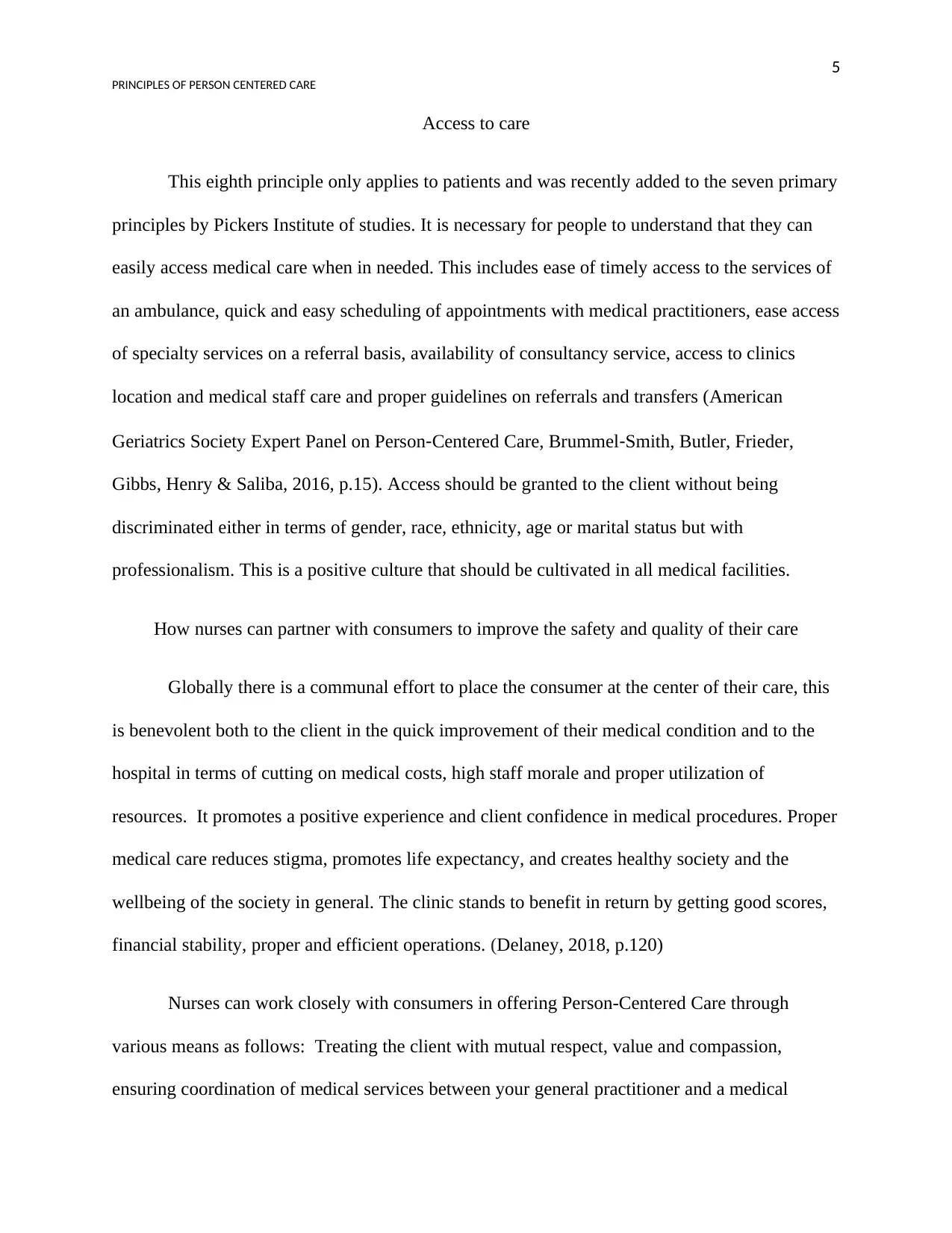
5
PRINCIPLES OF PERSON CENTERED CARE
Access to care
This eighth principle only applies to patients and was recently added to the seven primary
principles by Pickers Institute of studies. It is necessary for people to understand that they can
easily access medical care when in needed. This includes ease of timely access to the services of
an ambulance, quick and easy scheduling of appointments with medical practitioners, ease access
of specialty services on a referral basis, availability of consultancy service, access to clinics
location and medical staff care and proper guidelines on referrals and transfers (American
Geriatrics Society Expert Panel on Person‐Centered Care, Brummel‐Smith, Butler, Frieder,
Gibbs, Henry & Saliba, 2016, p.15). Access should be granted to the client without being
discriminated either in terms of gender, race, ethnicity, age or marital status but with
professionalism. This is a positive culture that should be cultivated in all medical facilities.
How nurses can partner with consumers to improve the safety and quality of their care
Globally there is a communal effort to place the consumer at the center of their care, this
is benevolent both to the client in the quick improvement of their medical condition and to the
hospital in terms of cutting on medical costs, high staff morale and proper utilization of
resources. It promotes a positive experience and client confidence in medical procedures. Proper
medical care reduces stigma, promotes life expectancy, and creates healthy society and the
wellbeing of the society in general. The clinic stands to benefit in return by getting good scores,
financial stability, proper and efficient operations. (Delaney, 2018, p.120)
Nurses can work closely with consumers in offering Person-Centered Care through
various means as follows: Treating the client with mutual respect, value and compassion,
ensuring coordination of medical services between your general practitioner and a medical
PRINCIPLES OF PERSON CENTERED CARE
Access to care
This eighth principle only applies to patients and was recently added to the seven primary
principles by Pickers Institute of studies. It is necessary for people to understand that they can
easily access medical care when in needed. This includes ease of timely access to the services of
an ambulance, quick and easy scheduling of appointments with medical practitioners, ease access
of specialty services on a referral basis, availability of consultancy service, access to clinics
location and medical staff care and proper guidelines on referrals and transfers (American
Geriatrics Society Expert Panel on Person‐Centered Care, Brummel‐Smith, Butler, Frieder,
Gibbs, Henry & Saliba, 2016, p.15). Access should be granted to the client without being
discriminated either in terms of gender, race, ethnicity, age or marital status but with
professionalism. This is a positive culture that should be cultivated in all medical facilities.
How nurses can partner with consumers to improve the safety and quality of their care
Globally there is a communal effort to place the consumer at the center of their care, this
is benevolent both to the client in the quick improvement of their medical condition and to the
hospital in terms of cutting on medical costs, high staff morale and proper utilization of
resources. It promotes a positive experience and client confidence in medical procedures. Proper
medical care reduces stigma, promotes life expectancy, and creates healthy society and the
wellbeing of the society in general. The clinic stands to benefit in return by getting good scores,
financial stability, proper and efficient operations. (Delaney, 2018, p.120)
Nurses can work closely with consumers in offering Person-Centered Care through
various means as follows: Treating the client with mutual respect, value and compassion,
ensuring coordination of medical services between your general practitioner and a medical
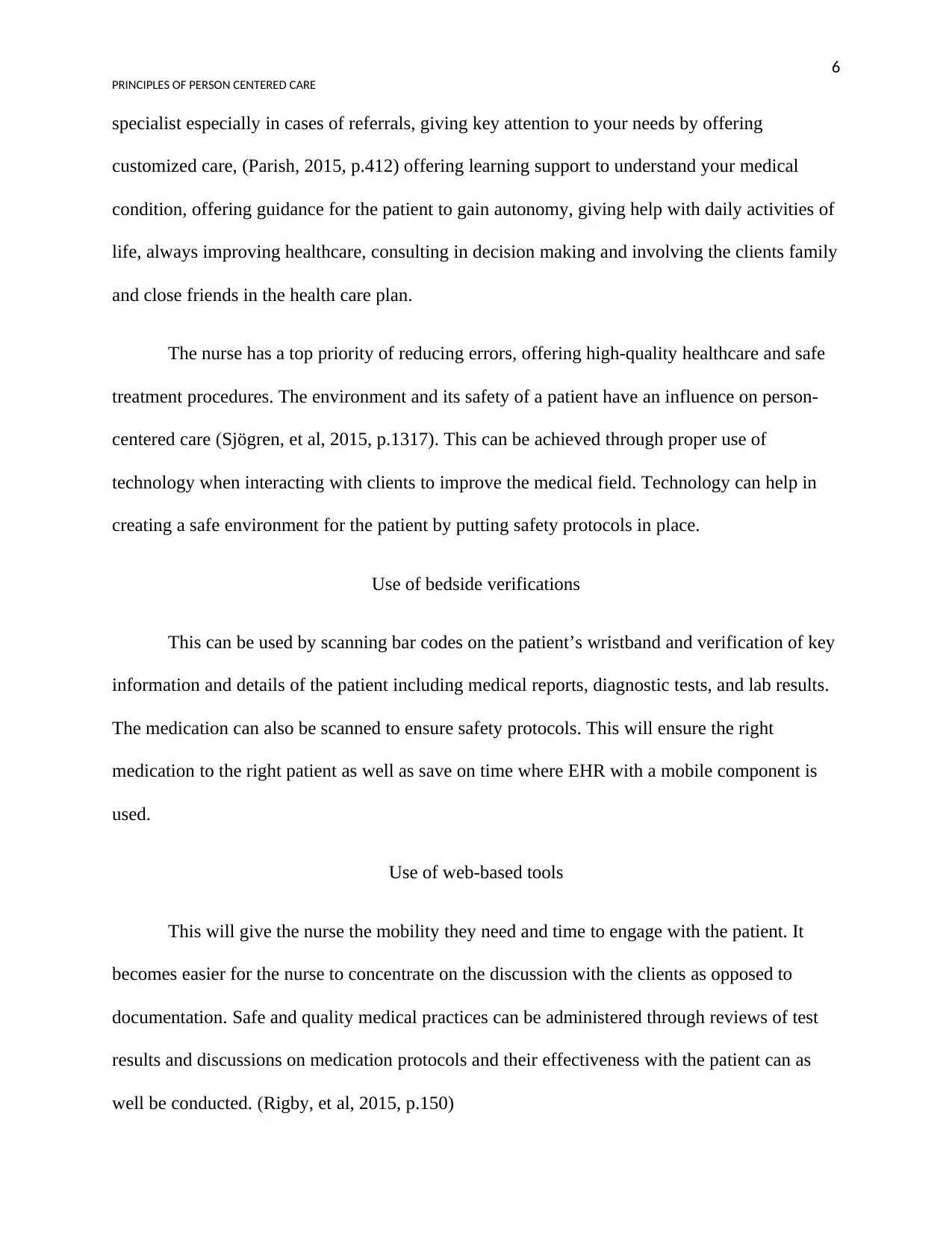
6
PRINCIPLES OF PERSON CENTERED CARE
specialist especially in cases of referrals, giving key attention to your needs by offering
customized care, (Parish, 2015, p.412) offering learning support to understand your medical
condition, offering guidance for the patient to gain autonomy, giving help with daily activities of
life, always improving healthcare, consulting in decision making and involving the clients family
and close friends in the health care plan.
The nurse has a top priority of reducing errors, offering high-quality healthcare and safe
treatment procedures. The environment and its safety of a patient have an influence on person-
centered care (Sjögren, et al, 2015, p.1317). This can be achieved through proper use of
technology when interacting with clients to improve the medical field. Technology can help in
creating a safe environment for the patient by putting safety protocols in place.
Use of bedside verifications
This can be used by scanning bar codes on the patient’s wristband and verification of key
information and details of the patient including medical reports, diagnostic tests, and lab results.
The medication can also be scanned to ensure safety protocols. This will ensure the right
medication to the right patient as well as save on time where EHR with a mobile component is
used.
Use of web-based tools
This will give the nurse the mobility they need and time to engage with the patient. It
becomes easier for the nurse to concentrate on the discussion with the clients as opposed to
documentation. Safe and quality medical practices can be administered through reviews of test
results and discussions on medication protocols and their effectiveness with the patient can as
well be conducted. (Rigby, et al, 2015, p.150)
PRINCIPLES OF PERSON CENTERED CARE
specialist especially in cases of referrals, giving key attention to your needs by offering
customized care, (Parish, 2015, p.412) offering learning support to understand your medical
condition, offering guidance for the patient to gain autonomy, giving help with daily activities of
life, always improving healthcare, consulting in decision making and involving the clients family
and close friends in the health care plan.
The nurse has a top priority of reducing errors, offering high-quality healthcare and safe
treatment procedures. The environment and its safety of a patient have an influence on person-
centered care (Sjögren, et al, 2015, p.1317). This can be achieved through proper use of
technology when interacting with clients to improve the medical field. Technology can help in
creating a safe environment for the patient by putting safety protocols in place.
Use of bedside verifications
This can be used by scanning bar codes on the patient’s wristband and verification of key
information and details of the patient including medical reports, diagnostic tests, and lab results.
The medication can also be scanned to ensure safety protocols. This will ensure the right
medication to the right patient as well as save on time where EHR with a mobile component is
used.
Use of web-based tools
This will give the nurse the mobility they need and time to engage with the patient. It
becomes easier for the nurse to concentrate on the discussion with the clients as opposed to
documentation. Safe and quality medical practices can be administered through reviews of test
results and discussions on medication protocols and their effectiveness with the patient can as
well be conducted. (Rigby, et al, 2015, p.150)
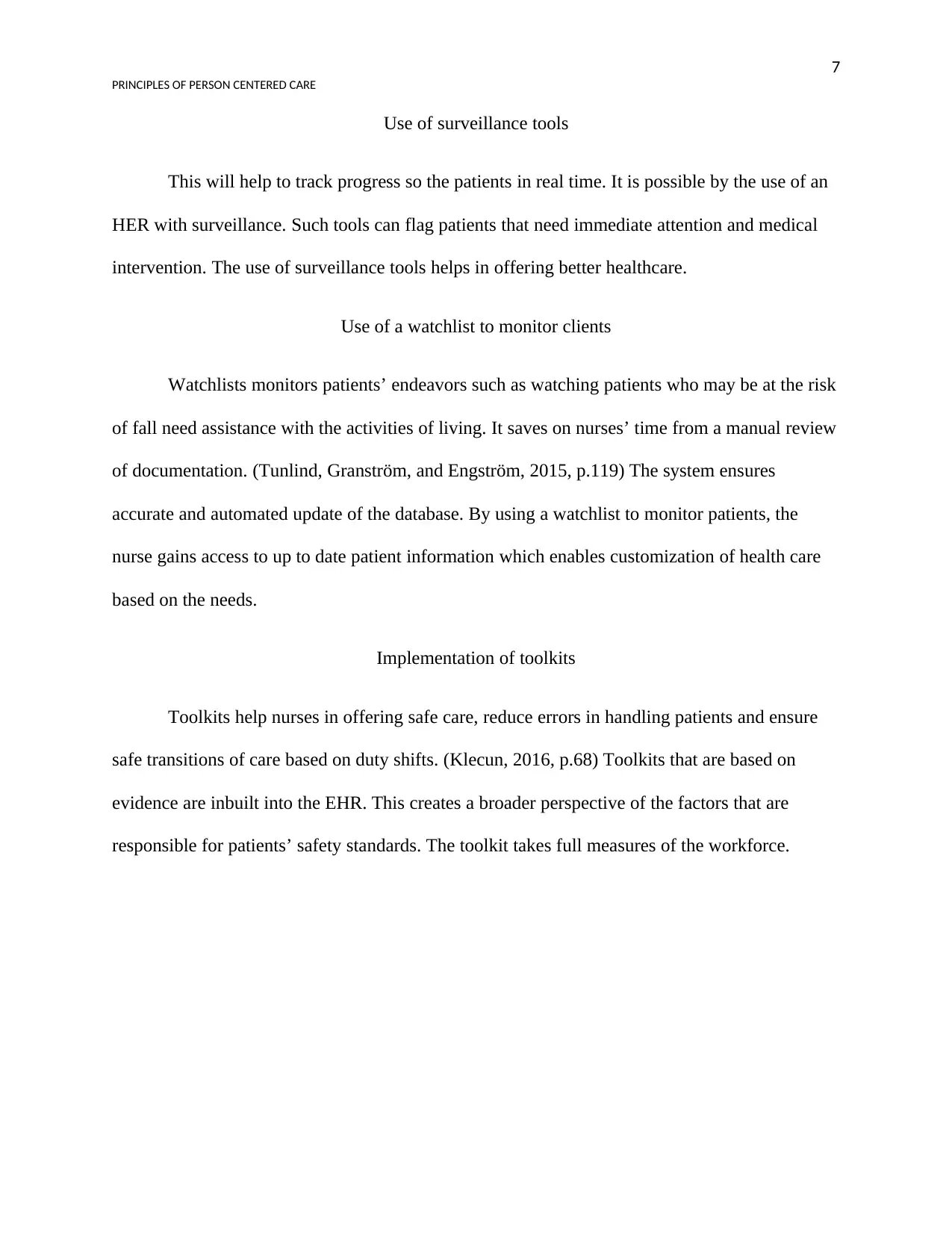
7
PRINCIPLES OF PERSON CENTERED CARE
Use of surveillance tools
This will help to track progress so the patients in real time. It is possible by the use of an
HER with surveillance. Such tools can flag patients that need immediate attention and medical
intervention. The use of surveillance tools helps in offering better healthcare.
Use of a watchlist to monitor clients
Watchlists monitors patients’ endeavors such as watching patients who may be at the risk
of fall need assistance with the activities of living. It saves on nurses’ time from a manual review
of documentation. (Tunlind, Granström, and Engström, 2015, p.119) The system ensures
accurate and automated update of the database. By using a watchlist to monitor patients, the
nurse gains access to up to date patient information which enables customization of health care
based on the needs.
Implementation of toolkits
Toolkits help nurses in offering safe care, reduce errors in handling patients and ensure
safe transitions of care based on duty shifts. (Klecun, 2016, p.68) Toolkits that are based on
evidence are inbuilt into the EHR. This creates a broader perspective of the factors that are
responsible for patients’ safety standards. The toolkit takes full measures of the workforce.
PRINCIPLES OF PERSON CENTERED CARE
Use of surveillance tools
This will help to track progress so the patients in real time. It is possible by the use of an
HER with surveillance. Such tools can flag patients that need immediate attention and medical
intervention. The use of surveillance tools helps in offering better healthcare.
Use of a watchlist to monitor clients
Watchlists monitors patients’ endeavors such as watching patients who may be at the risk
of fall need assistance with the activities of living. It saves on nurses’ time from a manual review
of documentation. (Tunlind, Granström, and Engström, 2015, p.119) The system ensures
accurate and automated update of the database. By using a watchlist to monitor patients, the
nurse gains access to up to date patient information which enables customization of health care
based on the needs.
Implementation of toolkits
Toolkits help nurses in offering safe care, reduce errors in handling patients and ensure
safe transitions of care based on duty shifts. (Klecun, 2016, p.68) Toolkits that are based on
evidence are inbuilt into the EHR. This creates a broader perspective of the factors that are
responsible for patients’ safety standards. The toolkit takes full measures of the workforce.
Paraphrase This Document
Need a fresh take? Get an instant paraphrase of this document with our AI Paraphraser
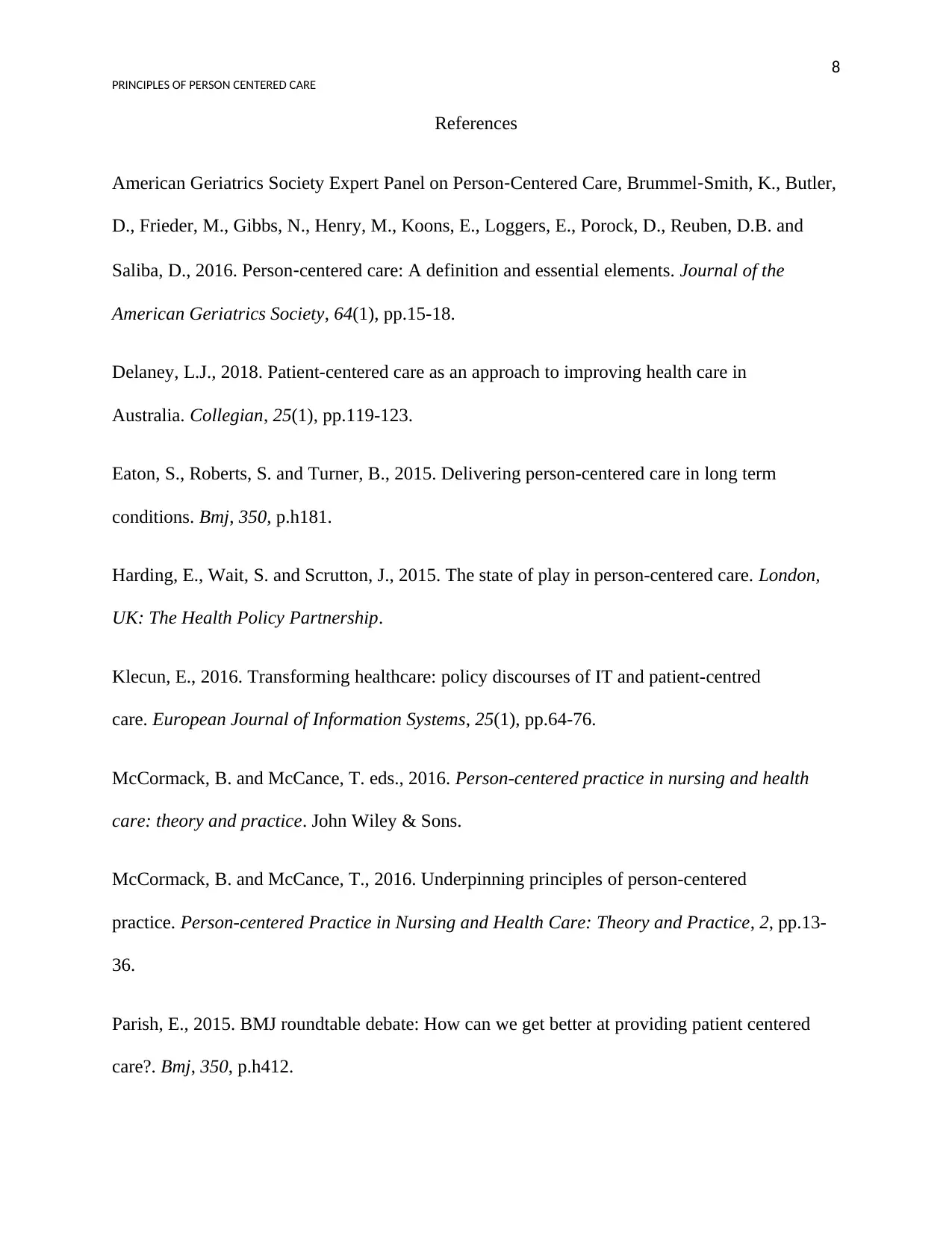
8
PRINCIPLES OF PERSON CENTERED CARE
References
American Geriatrics Society Expert Panel on Person‐Centered Care, Brummel‐Smith, K., Butler,
D., Frieder, M., Gibbs, N., Henry, M., Koons, E., Loggers, E., Porock, D., Reuben, D.B. and
Saliba, D., 2016. Person‐centered care: A definition and essential elements. Journal of the
American Geriatrics Society, 64(1), pp.15-18.
Delaney, L.J., 2018. Patient-centered care as an approach to improving health care in
Australia. Collegian, 25(1), pp.119-123.
Eaton, S., Roberts, S. and Turner, B., 2015. Delivering person-centered care in long term
conditions. Bmj, 350, p.h181.
Harding, E., Wait, S. and Scrutton, J., 2015. The state of play in person-centered care. London,
UK: The Health Policy Partnership.
Klecun, E., 2016. Transforming healthcare: policy discourses of IT and patient-centred
care. European Journal of Information Systems, 25(1), pp.64-76.
McCormack, B. and McCance, T. eds., 2016. Person-centered practice in nursing and health
care: theory and practice. John Wiley & Sons.
McCormack, B. and McCance, T., 2016. Underpinning principles of person-centered
practice. Person-centered Practice in Nursing and Health Care: Theory and Practice, 2, pp.13-
36.
Parish, E., 2015. BMJ roundtable debate: How can we get better at providing patient centered
care?. Bmj, 350, p.h412.
PRINCIPLES OF PERSON CENTERED CARE
References
American Geriatrics Society Expert Panel on Person‐Centered Care, Brummel‐Smith, K., Butler,
D., Frieder, M., Gibbs, N., Henry, M., Koons, E., Loggers, E., Porock, D., Reuben, D.B. and
Saliba, D., 2016. Person‐centered care: A definition and essential elements. Journal of the
American Geriatrics Society, 64(1), pp.15-18.
Delaney, L.J., 2018. Patient-centered care as an approach to improving health care in
Australia. Collegian, 25(1), pp.119-123.
Eaton, S., Roberts, S. and Turner, B., 2015. Delivering person-centered care in long term
conditions. Bmj, 350, p.h181.
Harding, E., Wait, S. and Scrutton, J., 2015. The state of play in person-centered care. London,
UK: The Health Policy Partnership.
Klecun, E., 2016. Transforming healthcare: policy discourses of IT and patient-centred
care. European Journal of Information Systems, 25(1), pp.64-76.
McCormack, B. and McCance, T. eds., 2016. Person-centered practice in nursing and health
care: theory and practice. John Wiley & Sons.
McCormack, B. and McCance, T., 2016. Underpinning principles of person-centered
practice. Person-centered Practice in Nursing and Health Care: Theory and Practice, 2, pp.13-
36.
Parish, E., 2015. BMJ roundtable debate: How can we get better at providing patient centered
care?. Bmj, 350, p.h412.
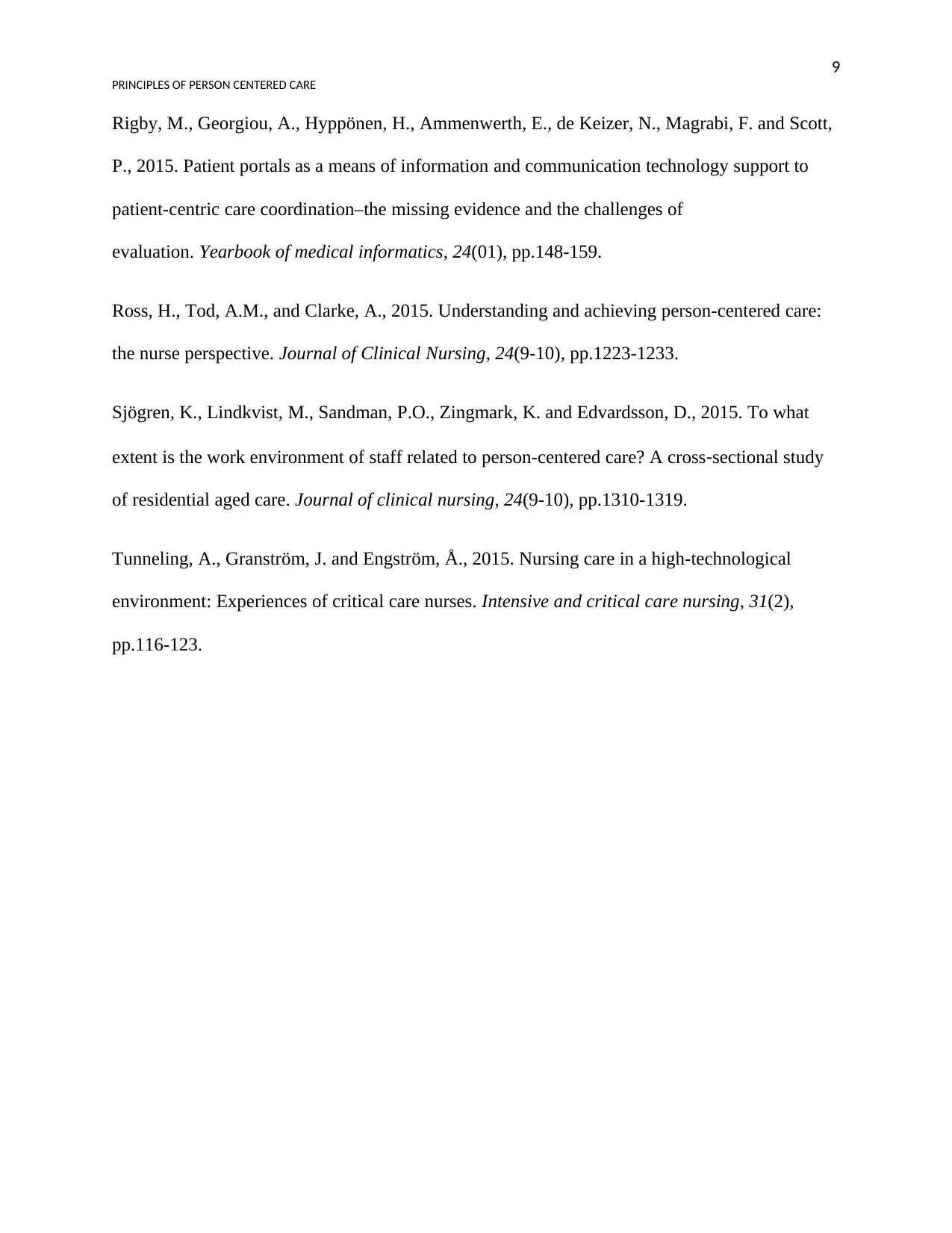
9
PRINCIPLES OF PERSON CENTERED CARE
Rigby, M., Georgiou, A., Hyppönen, H., Ammenwerth, E., de Keizer, N., Magrabi, F. and Scott,
P., 2015. Patient portals as a means of information and communication technology support to
patient-centric care coordination–the missing evidence and the challenges of
evaluation. Yearbook of medical informatics, 24(01), pp.148-159.
Ross, H., Tod, A.M., and Clarke, A., 2015. Understanding and achieving person-centered care:
the nurse perspective. Journal of Clinical Nursing, 24(9-10), pp.1223-1233.
Sjögren, K., Lindkvist, M., Sandman, P.O., Zingmark, K. and Edvardsson, D., 2015. To what
extent is the work environment of staff related to person-centered care? A cross‐sectional study
of residential aged care. Journal of clinical nursing, 24(9-10), pp.1310-1319.
Tunneling, A., Granström, J. and Engström, Å., 2015. Nursing care in a high-technological
environment: Experiences of critical care nurses. Intensive and critical care nursing, 31(2),
pp.116-123.
PRINCIPLES OF PERSON CENTERED CARE
Rigby, M., Georgiou, A., Hyppönen, H., Ammenwerth, E., de Keizer, N., Magrabi, F. and Scott,
P., 2015. Patient portals as a means of information and communication technology support to
patient-centric care coordination–the missing evidence and the challenges of
evaluation. Yearbook of medical informatics, 24(01), pp.148-159.
Ross, H., Tod, A.M., and Clarke, A., 2015. Understanding and achieving person-centered care:
the nurse perspective. Journal of Clinical Nursing, 24(9-10), pp.1223-1233.
Sjögren, K., Lindkvist, M., Sandman, P.O., Zingmark, K. and Edvardsson, D., 2015. To what
extent is the work environment of staff related to person-centered care? A cross‐sectional study
of residential aged care. Journal of clinical nursing, 24(9-10), pp.1310-1319.
Tunneling, A., Granström, J. and Engström, Å., 2015. Nursing care in a high-technological
environment: Experiences of critical care nurses. Intensive and critical care nursing, 31(2),
pp.116-123.
1 out of 9
Related Documents
Your All-in-One AI-Powered Toolkit for Academic Success.
+13062052269
info@desklib.com
Available 24*7 on WhatsApp / Email
![[object Object]](/_next/static/media/star-bottom.7253800d.svg)
Unlock your academic potential
© 2024 | Zucol Services PVT LTD | All rights reserved.





